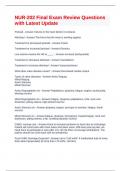Exam (elaborations)
NUR-202 Final Exam Review Questions with Latest Update
- Course
- Institution
Preload - Answer-Volume in the heart before it contracts Afterload - Answer-The force that the heart is working against Treatment for decreased preload - Answer-Fluids Treatment for increased preload - Answer-Diuretics Low volume causes the HR to ____. - Answer-Increase (tachycardia) ...
[Show more]




